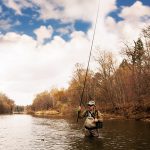Understanding Surf Conditions and Their Impact on Casting
If you want to improve your surf casting game, the first thing to understand is how surf conditions affect your performance. Everything from wind direction to wave height can change the way your bait flies and lands. Knowing when and where to cast isn’t just about luck—it’s about reading the environment and using it to your advantage.
How Wind Affects Your Cast
Wind plays a major role in casting distance and accuracy. A strong headwind can shorten your cast, while a tailwind can help carry your bait farther. Side winds, on the other hand, may push your line off course, making accuracy more difficult.
| Wind Direction | Effect on Casting | Tips |
|---|---|---|
| Headwind (blowing toward you) | Reduces distance | Use heavier sinkers; keep casts low and controlled |
| Tailwind (blowing behind you) | Increases distance | Take advantage for longer casts; use aerodynamic rigs |
| Crosswind (sideways) | Affects accuracy | Aim slightly upwind; tighten your line quickly |
Tides: Timing Is Everything
Tide movement changes water depth, current speed, and fish activity—all of which impact where you should cast. In general, incoming tides bring fish closer to shore as they follow baitfish into shallower water.
Best Tides for Surf Casting
- Incoming Tide: Great for casting closer to shore as fish move in with rising water.
- High Tide: Often productive because deeper water is within reach from the beach.
- Outgoing Tide: Can be good near channels or cuts where water funnels out, carrying baitfish.
Reading Wave Patterns
The size and rhythm of waves tell you a lot about underwater structure. Breaks in wave patterns usually indicate sandbars, troughs, or holes—prime spots where fish hang out. Casting just beyond or into these areas often yields better results.
Quick Tips for Using Waves to Your Advantage
- Look for calmer spots between breaking waves—these often mark deeper holes.
- Avoid casting directly into heavy breakers unless targeting species feeding in turbulent water.
- Time your cast between wave sets for smoother line control and better placement.
Choosing the Right Spot and Time
The combination of favorable wind, tide stage, and wave pattern determines the best time and place to cast. Early mornings and late afternoons are often ideal, especially during an incoming tide. Scout beaches at low tide to spot structure like sandbars or drop-offs that will be covered during high tide.
Ideal Conditions Checklist
- Mild tailwind or no wind at all
- Incoming or high tide
- Casting near structure like troughs or points
- Moderate wave action—not too rough, not too calm
By learning how to read surf conditions, you’ll be able to fine-tune your casting technique based on what nature throws at you. It’s not just about strength—it’s about strategy.
2. Gear Matters: Rod, Reel, and Line Selection for Long-Distance Casting
When it comes to surf fishing, having the right gear setup can make all the difference in casting farther and hitting your target with precision. Whether youre aiming to reach deeper waters or specific strike zones, understanding how your rod, reel, and line work together is key to boosting both distance and accuracy.
Surf Rod Length: The Foundation of Your Cast
The length of your surf rod plays a major role in how far you can cast. Longer rods generate more leverage and allow for a wider casting arc, which translates into greater distance. However, longer isn’t always better if you can’t handle it comfortably.
| Rod Length | Best Use | Pros | Cons |
|---|---|---|---|
| 8-10 ft | Short-range casting, easier handling | Lightweight, better control | Limited casting distance |
| 10-12 ft | Balanced range and accuracy | Versatile for most conditions | Might be bulky for some anglers |
| 12-14 ft+ | Long-distance casting in open beaches | Maximum casting range | Heavier, needs practice to control |
Selecting the Right Reel: Spinning vs Conventional
Your choice of reel also affects how far and accurately you can cast. Surf anglers usually choose between spinning reels and conventional (baitcasting) reels. Each has its strengths depending on your skill level and fishing conditions.
| Reel Type | Advantages | Challenges | Best For |
|---|---|---|---|
| Spinning Reel | Easier to use, fewer backlashes, great for beginners | Slightly less distance than conventional reels at expert level | Everyday surf fishing, windy conditions |
| Conventional Reel | Better potential for long-distance casting with proper technique | Takes time to master; prone to bird’s nests (line tangles) | Experienced anglers targeting maximum range |
The Role of Fishing Line: Type and Diameter Matter
The type of line you spool onto your reel has a big impact on how smoothly it casts through the guides of your rod. Thinner lines create less friction, which helps them fly farther. But strength is also important when youre dealing with strong surf currents or larger fish.
| Line Type | Main Features | Best Use Case |
|---|---|---|
| Braided Line (e.g., 20-30 lb test) | Thin diameter, minimal stretch, high sensitivity | Long casts with better feel on strikes; ideal for clear water where visibility isnt an issue |
| Monofilament Line (e.g., 15-20 lb test) | Slightly thicker, more stretch, affordable and forgiving on knots/tangles | Cushions shock from big fish; good for beginners or rocky surf areas |
Tuning Your Setup for Optimal Performance
The sweet spot lies in matching these three components—rod length, reel type, and line—to your style of fishing and the conditions youll face. For example, pairing a 12-foot rod with a quality spinning reel spooled with 30 lb braided line gives many surf anglers a balanced setup that allows for long yet accurate casts while maintaining enough strength to handle tough fights.
Quick Tip:
If youre struggling with distance even after upgrading gear, check your line guides—they should be clean and appropriately sized for your line to reduce drag during the cast.
Selecting the right combination of gear may take some trial and error, but once dialed in, it can dramatically improve both how far you cast and how precisely you place your bait—getting you closer to that trophy catch every time.

3. Mastering the Pendulum and Off-the-Ground Casts
If youre serious about surf fishing and want to cast farther with more accuracy, it’s time to step up your game by learning two advanced techniques: the pendulum cast and the off-the-ground cast. These casting styles are go-to methods for tournament anglers and experienced surfcasters who need distance and control to reach fish holding beyond the breakers.
Understanding the Pendulum Cast
The pendulum cast is a powerful, high-energy technique that uses a full-body motion to generate maximum rod load and line speed. It’s not for beginners, but once mastered, it can significantly increase your casting range — often over 150 yards with proper form and gear.
Key Steps in the Pendulum Cast:
- Setup: Start with the sinker swinging freely like a pendulum behind you.
- Timing: Initiate your body rotation as the sinker reaches its farthest point back.
- Power Transfer: Use your hips, shoulders, and arms in sync to whip the rod forward.
- Follow Through: Let your rod tip finish high to maximize lift and distance.
Pendulum Cast Pros & Cons
| Pros | Cons |
|---|---|
| Extreme casting distance | Takes time to master |
| Efficient energy transfer | Needs open space behind you |
| Ideal for competitive casting | Harder on gear if done incorrectly |
The Off-the-Ground Cast Explained
The off-the-ground cast is a simpler alternative that still offers excellent distance with less risk of tangling or misfires. It’s great for intermediate anglers looking to transition from overhead or side casts without jumping straight into complex motions.
How to Perform an Off-the-Ground Cast:
- Sinker Position: Lay the sinker on the ground behind you with some tension on the line.
- Smooth Lift: Begin lifting your rod while rotating your body forward.
- Release Point: Accelerate into the cast and release at just past vertical for optimal flight path.
- Rod Control: Keep movements fluid and avoid jerky motions for consistent results.
Off-the-Ground Cast Pros & Cons
| Pros | Cons |
|---|---|
| Easier than pendulum cast | Slightly less distance potential |
| Smoother learning curve | Loses power if not timed right |
| Lowers chances of backlash | Requires flat ground behind you |
Tuning Your Technique with Practice
No matter which advanced casting method you choose, practice is key. Start with shorter rods and lighter weights before working up to heavier setups. Record yourself or ask a buddy to watch your form so you can make small tweaks over time. With enough reps, both pendulum and off-the-ground casts can become second nature — giving you the edge when targeting fish far from shore.
4. Fine-Tuning Your Casting Form and Mechanics
When it comes to surf fishing, casting isn’t just about strength—it’s about technique. By fine-tuning your form and mechanics, you can dramatically improve both the accuracy and distance of your casts. Lets break down three key elements: body positioning, weight transfer, and release timing.
Body Positioning
Your stance plays a major role in how effectively you can cast. Think of it like setting up for a golf swing or a baseball pitch—your body needs to be aligned for maximum control and power.
Tips for Proper Stance:
- Stand with feet shoulder-width apart
- Point your front foot slightly toward the target
- Keep your knees slightly bent for balance
- Rotate your shoulders in line with your casting direction
Weight Transfer
Powerful casts come from using your whole body, not just your arms. The secret lies in transferring your weight smoothly from your back foot to your front foot as you cast. This motion helps generate momentum without overexerting your upper body.
| Step | Action | Why It Matters |
|---|---|---|
| 1 | Start with weight on back foot | Builds potential energy for the cast |
| 2 | Shift weight forward during rod load-up | Adds power through momentum |
| 3 | Finish with weight on front foot at release | Ensures a smooth and controlled follow-through |
Release Timing
The moment you let go of the line is critical. Release too early, and the bait flies upward; too late, and it slams into the surf. The goal is to release at just the right point in your casting arc.
How to Nail the Timing:
- Aim to release when the rod tip is slightly past vertical (around the 10 oclock position)
- Practice dry casting to develop muscle memory without hooks or bait
- Use slow-motion video on your phone to analyze your form and release point
Pro Tip:
If youre struggling with consistency, try marking your rod grip where your hands should go. A consistent hand placement can help you repeat successful casts more easily.
Mastering these fundamentals—stance, weight transfer, and timing—can make all the difference in surfcasting. With practice, youll notice longer casts that land exactly where you want them.
5. Practice Drills to Enhance Accuracy and Distance
Improving your surf casting skills takes more than just time on the beach — it requires intentional practice with drills that mirror real fishing scenarios. By using specific routines, you can fine-tune your technique, build muscle memory, and gain better control over your cast’s distance and accuracy.
Set Up a Target Zone
One of the simplest yet most effective ways to improve casting accuracy is by practicing with target zones. Use items like hula hoops, buckets, or even drawn circles in the sand or grass to simulate where youd want your bait to land. Stand at varying distances and try to consistently place your sinker or plug within the target zone.
Target Zone Drill
| Distance | Target Size | Goal |
|---|---|---|
| 30 yards | 3-foot circle | Hit target 8 out of 10 times |
| 50 yards | 5-foot circle | Hit target 6 out of 10 times |
| 75 yards | 6-foot circle | Hit target 5 out of 10 times |
Mimic Real Surf Conditions
If possible, practice in conditions that resemble the beach environment. Wind direction, uneven footing, and line drag all play a role in real surf fishing. Practicing on an open field with wind present helps you learn how to adjust your angle and force accordingly.
Casting for Distance Drill
This drill helps develop strength and timing while maintaining form. Use a practice weight (around 2-4 oz) and mark off distances in increments using cones or markers.
Casting Progression Plan
| Casting Style | Total Distance Goal | No. of Repetitions |
|---|---|---|
| Lob Cast (Basic) | 60 yards+ | x15 casts |
| Pendulum Cast (Advanced) | 100 yards+ | x10 casts |
| Off-the-Ground Cast | 80 yards+ | x12 casts |
Add Movement Before Casting
A lot can change between spotting fish activity and executing your cast. To simulate this, add movement into your drill — take a few steps before casting to mimic walking along the shore or repositioning quickly when a school moves.
The Mobile Cast Drill:
- Step 1: Walk or jog five steps forward.
- Step 2: Stop, plant feet, and cast toward the target zone.
- Main Benefit: Trains quick setup and balance under pressure.
Create a Weekly Practice Routine
A consistent training schedule makes a big difference. Here’s a sample weekly plan for surf anglers looking to boost both accuracy and power:
Sample Weekly Casting Plan
| Day | Main Focus | Description |
|---|---|---|
| Monday | Casting Form Check-up | Smooth slow-motion casts; record & review technique. |
| Wednesday | Target Zone Drills | Aim for accuracy from multiple distances. |
| Friday | Casting for Distance | Pendulum/OTG techniques; measure longest cast. |
| Saturday (Optional) | Mimic Real Conditions | Add movement, wind simulation, or practice on sand. |
The more realistic your practice sessions are, the more confident youll be when youre actually out there on the shoreline. Put in the work now so every cast counts when it matters most.


